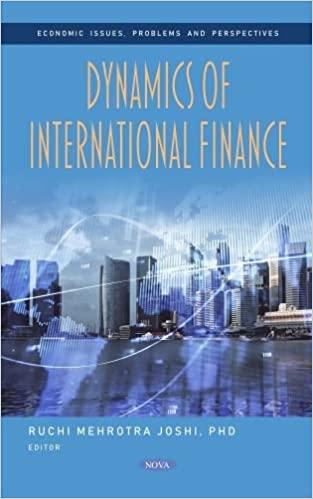Question
Please write down your choice in the blank before the question. 1. _____ Which of the following exchange rates is in direct quotation? a. 1000
Please write down your choice in the blank before the question.
1. _____ Which of the following exchange rates is in direct quotation? a. 1000 Korean won/US dollar, from the perspective of a U.S. investor. b. 150 Japanese yen/euro, from the perspective of a Japanese investor. c. 0.9580 euro/Swiss franc, from the perspective of a Swiss investor. d. 0.06250 Chinese yuan/Japanese yen, from the perspective of a Japanese investor.
2. _____ Which of the following statements is NOT CORRECT? a. Exchange rate risk is the risk that the cash flows from a foreign project, when converted to the parent companys currency, will be worth less than was originally projected because of exchange rate changes. b. Multinational financial management differs from domestic financial management only in that it requires financial managers to consider an extra factor - the changing currency values. c. Exchange rate riskinfluences not only the free cash flow of a multinational firm, but also its weighted average cost of capital. d. The cross rate between the Chinese yuan and Indian rupee can be found using their exchange rates against a third currency, for example, the U.S. dollar.
3. _____ Which of the following statements is CORRECT? a. If the investments in Japan made by U.S. businesses increase substantially, holding everything else constant, U.S. dollar will appreciate against Japanese yen. b. If the U.S. is running a deficit trade balance with Japan, then, holding everything else constant, we would expect the value of the Japanese yen to depreciate against the U.S. dollar. c. If the Federal Reserve tapers its quantitative easing, holding everything else constant, the U.S. dollar will appreciate against Japanese yen. d. If Japanese yen depreciates against U.S. dollar, holding everything else constant, Japanese imports from the U.S. will increase.
4. _____ Which of the following statements is CORRECT? a. If one can buy more of Japanese yen in the forward market using a U.S. dollar than in the spot market, then forward Japanese yen is selling at a premium to the spot rate. b. If one can buy less of Japanese yen in the forward market using a U.S. dollar than in the spot market, the spot Japanese yen is selling at a premium to the forward rate. c. If the U.S. interest rates are lower than the Japanese interest rates, holding all else equal, the spot Japanese yen is selling at a discount to the forward rate. d. If the U.S. interest rates are higher than the Japanese interest rates, holding all else equal, the forward Japanese yen is selling at a premium to the spot rate.
5. _____ Which of the following is NOT true about correctly using the interest rate parity? a. Determine the home currency first, and then you can determine which interest rate is the home interest rate, and what quotation is the direct quotation for exchange rates. b. Use the direct quotations for both the forward and spot exchange rates. c. Use annual interest rates in the baseline version of interest rate parity. d. Use annual interest rates in the multi-year interest rate parity.
Step by Step Solution
There are 3 Steps involved in it
Step: 1

Get Instant Access to Expert-Tailored Solutions
See step-by-step solutions with expert insights and AI powered tools for academic success
Step: 2

Step: 3

Ace Your Homework with AI
Get the answers you need in no time with our AI-driven, step-by-step assistance
Get Started


